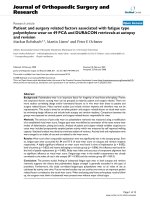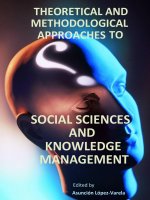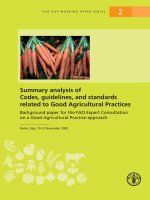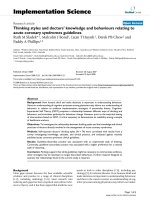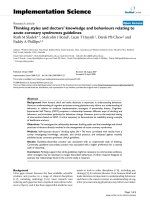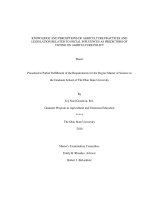Knowledge and perceptions of agriculture practices and legislation related to social influences as predictors of voting on agriculture policy
Bạn đang xem bản rút gọn của tài liệu. Xem và tải ngay bản đầy đủ của tài liệu tại đây (1.78 MB, 160 trang )
KNOWLEDGE AND PERCEPTIONS OF AGRICULTURE PRACTICES AND
LEGISLATION RELATED TO SOCIAL INFLUENCES AS PREDICTORS OF
VOTING ON AGRICULTURE POLICY
Thesis
Presented in Partial Fulfillment of the Requirements for the Degree Master of Science in
the Graduate School of The Ohio State University
By
Joy Noel Goodwin, B.S.
Graduate Program in Agricultural and Extension Education
*****
The Ohio State University
2010
Master‟s Examination Committee:
Emily B. Rhoades, Advisor
Robert J. Birkenholz
Copyright by
Joy N. Goodwin
2010
ABSTRACT
Animal protection legislation continues to be prevalent on U.S. political agendas,
therefore, it is important for agriculture communicators to be able to communicate with
stakeholders about the economic and social value of agriculture. In addition, as animal
rights lobbying organizations continue to improve and strengthen their public presence, it
is critical that agricultural communicators make the public aware and informed of
agricultural issues through increased use of mass media technologies. This study sought
to examine the agricultural presence in a technologically advanced social networking
medium as well as to gain an understanding of consumers‟ knowledge of agriculture.
This study was unique in that it assessed this information and then related it to the voting
outcomes of two different animal protection legislation bills. Theories used to guide this
study included messaging appeals, social cognitive theory, social learning theory,
cognitive dissonance theory, semiotics, and knowledge gap.
A content analysis was performed on a census of 111 YouTube videos related to
California Proposition 2. In addition, 508 questionnaires were collected from voluntary
participants at the 2009 Ohio State Fair. Basic descriptive quantitative statistics were
completed on the data. In addition, open coding was used to analyze the qualitative
portions of the study.
ii
Results of this study suggest that the YouTube videos related to Proposition 2
mostly supported the issue, while only a small fraction opposed the proposition. In
addition, the majority of the videos used emotional messaging appeals while rational
appeals were used on a less frequent basis. Findings from the questionnaire indicate that
consumers do not differentiate between animal rights and animal welfare. Consumers
reported positive regards for the humane treatment of animals and perceived that the
majority of farmers raised their animals in a humane manner. Most of the participants
knew that the majority of livestock were raised in conventional livestock housing
systems, but indicated that traditional housing was more humane. Participants expressed
that traditional livestock housing produced the healthiest animals, but conventional
housing was most protected from disease. In addition, consumers identified that
traditional housing would produce the safer and most wholesome food, while
conventional housing would produce more consumer friendly prices. The majority of
respondents were unaware of livestock legislation that had passed in six states and were
also unable to accurately describe the difference between HSUS and a local humane
society. Lastly, the participants favored the idea of an Ohio Livestock Care Standards
Board now known as Issue 2.
Suggestions were made for further research. In addition, recommendations were
made to agricultural communicators and educators. These recommendations included
suggestions for improving agricultural campaigns, further research ideas, and educational
suggestions.
iii
Dedicated to my parents who provide unconditional love and support and who
taught me the value of hard work and dedication.
iv
ACKNOWLEDGEMENTS
The completion of my thesis would not have been possible without the support I
received from numerous individuals. First I would like to thank my adviser Dr. Emily
Rhoades for her assistance, support, willingness to provide revisions for numerous
documents, and for giving me the opportunity to conduct research and present at
conferences. I would also like to thank Dr. Rhoades for recognizing my abilities and
encouraging me to pursue a PhD. Dr. Rhoades‟ ability to share her knowledge of
agricultural communications, research, and evaluation of theories has enabled me to grow
as a learner while completing my graduate work at The Ohio State University. I would
also like to thank my committee member Dr. Birkenholz for providing valuable input and
allowing me to have the opportunity to work with him.
Without the support of the Ohio Farm Bureau, my research would not have been
possible. Specifically I would like to thank Pat Petzel, Vice President of
Communications, and Cara Lawson, Promotion Specialist, for their assistance in the
development of the research questionnaire. Additionally, I am grateful for their help in
organizing the arrangements of the booth at the Ohio State Fair, subject incentives, and
admission, parking passes, and food for those who assisted in administering the
questionnaires.
Lastly, I would like to thank my family and friends for their love and support. I
thank my dad, Chris Goodwin for allowing me to vent during phone calls, offering a
v
shoulder to cry on, and for his encouragement. I would like to thank my mom, Laura
Goodwin for always being supportive, for her nurturing nature, and reminding me to
smile. I owe thanks to my little brother, Seth Goodwin for offering his opinions when
asked and being a resource for a good laugh. I am also thankful for my Grandmother, Pat
Nesbitt and her thoughtful cards and supportive phone calls. Additionally, I am grateful
to have Nate Rumble in my life and I thank him for his continued support,
encouragement, and ability to tolerate me at my worst. Last but not least, I would like to
thank my roommate and long time friend Carla Jagger as we were able to share similar
frustrations and encouraging thoughts while completing our Master‟s at the same time.
vi
VITA
May 27, 1986……………………………….. Born – Marion, Ohio
2005-2006………………………………….. Intern, Kalmbach Feeds Inc.
2006………………………………………... A.S. Agriculture, The Ohio State
University Agricultural Technical
Institute
2006-2008………………………………...... Intern, Hord Livestock Inc.
2007………………………………………... Intern, USDA Farm Service Agency
2007………………………………………... B.S. Agriculture, The Ohio State
University
2008-2010………………………………….. IRB Protocol Analyst, The Ohio
State University
FIELDS OF STUDY
Major Field: Agricultural and Extension Education
Area of Emphasis: Agricultural Communications
vii
TABLE OF CONTENTS
Abstract………………………………………………………………………… ii
Dedication…………………………………………………………………….. iv
Acknowledgments……………………………………………………………... v
Vita…………………………………………………………………………….vii
List of Figures………………………………………………………………….xii
List of Tables………………………………………………………………….xiii
Chapters
1. Introduction……………………………………………………………..1
1.1
History of Animal Rights……………………………………….1
1.2
Recent Livestock Legislation…………………………………..5
1.3
California Proposition 2………………………………………..6
1.4
Ohio‟s Issue 2…………………………………………………..9
1.5
Animal Rights vs. Animal Welfare…………………………...11
1.6
Internet Usage and Young Voters…………………………….12
1.7
YouTube in Politics and Agriculture………………………….15
1.8
Knowledge and Perceptions of Agriculture…………………...16
1.9
Images…………………………………………………………18
1.10 Statement of the Problem……………………………………...19
1.11 Purpose of the Study…………………………………………..20
1.12 Research Objectives…………………………………………...21
1.13 Limitations…………………………………………………….22
1.14 Definition of Terms……………………………………………22
2. Literature Review………………………………………………………24
2.1
Messaging Appeals…………………………………………….24
2.2
Emotional Appeals in Political Advertisements……………….25
2.3
Emotional and Rational Appeals in TV Advertising…………..26
2.4
Demographics in Advertising………………………………….27
2.5
Social Cognitive Theory………………………………………28
2.6
Social Cognitive Theory in Practice…………………………...31
2.7
Social Learning Theory………………………………………..33
2.8
Social Learning Theory in Practice……………………………35
2.9
Cognitive Dissonance Theory………………………………...36
viii
2.10
2.11
2.12
2.13
2.14
2.15
2.16
Cognitive Dissonance Theory and Special Interests Groups….37
Cognitive Dissonance and Voting……………………………..38
Semiotics………………………………………………………39
Semiotics in Advertising………………………………………41
Knowledge Gap Theory……………………………………….43
Knowledge Gap Theory in a Health Campaign……………….44
Summary………………………………………………………45
3. Methods………………………………………………………………...46
3.1 Phase 1…………………………………………………………….47
3.1.1 Research Design…………………………………………...47
3.1.2 Subject Selection…………………………………………..47
3.1.3 Instrumentation……………………………………………48
3.1.4 Data Collection…………………………………………….53
3.1.5 Validity…………………………………………………….53
3.1.6 Reliability………………………………………………….54
3.1.7 Data Analysis……………………………………………...55
3.2 Phase 2……………………………………………………………..55
3.2.1 Research Design…………………………………………...55
3.2.2 Subject Selection…………………………………………..56
3.2.3 Instrumentation……………………………………………57
3.2.4 Data Collection…………………………………………....62
3.2.5 Validity...………………………………………………….62
3.2.6 Reliability…………………………………………...……..65
3.2.7 Data Analysis……………………………………………...66
3.3 Summary…………………………………………………………..66
4. Results………………………………………………………………….67
4.1 Demographics……………………………………………………..67
4.1.1 Phase 1 Demographics…………………………………….68
4.1.2 Phase 2 Demographics…………………………………….70
4.2 Objective 1: To describe characteristics of YouTube videos used
in a livestock production legislative campaign…………………...74
4.3 Objective 2: To explain how rational and emotional appeals were
used in a livestock production legislative campaign online....…....79
ix
4.4 Objective 3: To assess a sample of the general public‟s knowledge
and perceptions of humane treatment in livestock production
practices……………………………………………………………84
4.5 Objective 4: To assess a sample of the general public‟s perceptions
of images picturing traditional and conventional
livestock housing………………………………………………….88
4.6 Objective 5: To assess a sample of the general public‟s knowledge
and perceptions of current and proposed livestock
production regulations…………………………………………….96
4.7 Summary…………………………………………………………..99
5. Discussion……………………………………………………………100
5.1 Conclusions………………………………………………………101
5.1.1 Demographic Conclusions……………………………….101
5.1.2 Objective 1: To describe characteristics of YouTube
videos used in a livestock production legislative
campaign………………………………………………...103
5.1.3 Objective 2: To explain how rational and emotional appeals
were used in a livestock production legislative campaign
online……………………………………………………..106
5.1.4 Objective 3: To assess a sample of the general public‟s
knowledge and perceptions of humane treatment in
livestock productions practices…………………………..107
5.1.5 Objective 4: To assess a sample of the general public‟s
perceptions of images picturing traditional and
conventional livestock housing…………………………...108
5.1.6 Objective 5: To assess a sample of the general public‟s
knowledge and perceptions of current and proposed
livestock production regulations……………………….....111
5.2 Limitations……………………………………………………….113
5.3 Recommendations………………………………………………..114
5.3.1 Recommendations for Researchers………………………114
5.3.2 Recommendations for Agricultural Communicators
and Educators…………………………………………….115
5.4 Summary…………………………………………………………117
x
List of References……………………………………………………………118
Appendices…………………………………………………………………..130
Appendix A: Research Proposal Submitted to Institutional
Review Board………………………………………….131
Appendix B: YouTube Coding Sheet………………………………...133
Appendix C: YouTube Coding Guide………………………………..136
Appendix D: Directly Administered Questionnaire…………………..139
Appendix E: Picture A – Conventional Livestock Housing Methods...143
Appendix F: Picture B – Traditional Livestock Housing Methods…...145
xi
LIST OF FIGURES
Figure
Page
1
Extended Social-cognitive Model of Political Socialization and Political
Participation in the Life Span…………………………………………….....32
2
Pierce‟s Model of a Sign……………………………………………………40
3
Example of Celebrity Influence in YouTube Videos……………………….78
4
Example of Guilt Appeal in YouTube Videos……………………………...80
5
Example of Empathy in YouTube Videos………………………………….81
6
Example of Gain-loss in YouTube Videos…………………………………83
7
Images Used in Study for Comparison……………………………………..89
xii
LIST OF TABLES
Table
Page
3.1
Examples of Messaging Appeal Coding Questions………………………...51
3.2
Examples of Video Influence Coding Questions…………………………...52
3.3
Examples of Questions Assessing Animal Rights and Animal Welfare……58
3.4
Examples of Questions Assessing Perceptions of Livestock Housing……..60
3.5
Examples of Questions Assessing Perceptions and Knowledge of
Legislation…………………………………………………………………..61
4.1
Demographics of People Delivering the Message………………………….69
4.2
Demographics of Participants………………………………………………71
4.3
Experience with Agriculture………………………………………………..73
4.4
Sponsors of YouTube Videos………………………………………………76
4.5
Segments Covered by Proposition 2 Videos………………………………..77
4.6
Feeling/Emotional Appeals Used in Videos………………………………...82
4.7
Logical/Rational Appeals Used in Videos…………………………………..84
4.8
Do Farmers in Ohio Raise Their Animals in a Humane Manner?..................86
4.9
How Important is the Humane Production of Food Animals?.......................87
4.10
Improvement of Care through Livestock Care Amendment………………..98
xiii
CHAPTER 1
INTRODUCTION
Throughout history humans have relied on animals for food, protein, and many
byproducts. As the domestication of animals has evolved, society has increasingly
become more concerned with the well being and treatment of animals. As a result, groups
collectively known as animal rights organizations have emerged and animal protection
legislation has become prevalent in the political agenda. The mass media plays a key role
in covering such legislation and developing consumer‟s perceptions of animal care.
However, the influence of celebrities, media images and popular networking sites such as
YouTube seem to be disseminating an emotional stance on animal care rather than a
scientific base.
History of Animal Rights
There is evidence that humans were thinking about the cognition of animals in the
17th century when Rene Descartes philosophized that animals had no thought (Regan,
2004). Since then, more theories have been posited about the cognition of animals. Many
people now believe that animals possess “conscious awareness” (Regan, 2004, pg. 2).
This in turn suggests that animals can feel pain, think, plan, and possibly have feelings.
When animals are afforded human like characteristics, many people identify with them
and become concerned with the way in which they are treated and cared for, thus
resulting in a push for animal protection.
1
The European Union has led the way in animal protection standards. In 1822,
Great Britain implemented their first animal protection legislation (Radford, 1996). This
legislation was titled „An Act to Prevent the Cruel and Improper Treatment of Cattle,‟
which later became known as the Martin‟s Act (Radford, 1996). More recently, the
Treaty of Rome, written in 1957, addressed the concern for animal protections (Sullivan,
Vietzke, & Coyne, 2008). In 1997, the Treaty of Amsterdam provided revisions to the
Treaty of Rome, which included additional animal protection measures (Sullivan et al.,
2008). In addition to the measures included under the Treaty, numerous others have been
developed in the European Union; some of these include the Wild Mammals (Protection)
Act, Animal Health Act, and Welfare of Animals (Slaughter or Killing) Regulations
(Radford, 1996). Animal protection laws have continued to progress in the European
Union, and treatment regulations have been initiated on animal production systems,
including calves and egg laying hens. Additionally, politicians have banned veal crates
(Sullivan et al., 2008). With the success of these acts, similar legislation has begun to be
seen in other countries, including the United States.
The first animal protection organization was formed in the United States in 1866;
this organization was known as The American Society for the Protection of Animals
(Jasper, 1996). However, it was not until the last 30 years that animal rights has surfaced
and intensified in American society (Garner, 1996). In the early 1980s, the animals rights
organization People for the Ethical Treatment of Animal (PETA) was developed (Jasper,
1996). In addition, during the 1980‟s visible animal rights protests formed in the United
States (Jasper, 1996). Videos and shocking footage of animal research labs were released
through the news media in 1981 and 1984 by PETA and the Animal Liberation Front
2
(ALF). News coverage of the abuse in animal laboratories provided a boost to the animal
rights movement. By the end of the 1980s, one million Americans supported animal
rights organizations through various forms of contribution. Protests peaked in June of
1990 when 30,000 activists participated in the „March for the Animals‟ in Washington
D.C. (Jasper, 1996). The concern for animal protection among the general public has
made animal rights and protections prevalent in the United States political agenda
(Garner, 1996).
Prior to the movement toward animal protection, two primary federal regulations
were in place in the United States concerning animals. These included the Humane
Methods of Slaughter Act of 1901 and the Federal Meat Inspection Act of 1906 (Becker,
2009). The Humane Methods Slaughter Act stated that “…livestock must be slaughtered
in a humane manner to prevent needless suffering, research methods on humane methods
of slaughter, the non-applicability of these statues to religious or ritual slaughter, and the
investigation into the care of non-ambulatory livestock” (“Humane Methods,” 2009). In
addition, the Federal Meat Inspection Act provides regulations on: ante mortem and post
mortem inspections, humane methods of slaughter, meat inspectors, marks of inspection,
labeling, packaging, sanitation, export inspections, import inspections, storage, handling,
and record keeping, among other things (Food Safety Inspection Service, 2009).
In 1966, the Animal Welfare Act became a federal law in the United States
(United States Department of Agriculture, 2009e). Since then the Animal Welfare Act
has been amended six times, the most current amendment being in 2007 (United States
Department of Agriculture, 2009e). The Animal Welfare Act has provided many benefits
in terms of animal welfare in the United States; originally set legislation to “…regulate
3
the transportation, sale and handling of dogs, cats, and certain other animals intended to
be used for purposes of research or experimentation, and for other purposes” (United
States Department of Agriculture, 2009a). The Act has been expanded to include: all
warm blooded animals being used for experimentation or exhibition, has set restrictions
on animal fighting, set requirements of health certifications by a veterinarian, established
that an Institutional Animal Care and Use Committee must be in place at institutions of
animal experimentation in order to insure the most humane care, and created holding
periods for shelter animals (United States Department of Agriculture, 2009f; United
States Department of Agriculture, 2009b; United States Department of Agriculture,
2009c; United States Department of Agriculture, 2009d). Animal protection regulations
have increasingly become part of the United States political agenda, but they have also
become more prevalent on the minds of members of the Senate and House.
An animal rights lobbying organization, The Humane Society of the United States
(HSUS), released a humane scorecard for the members of 2008-2009, 110th congress.
According to their score card, 27 of the United States Senators scored a 100 or 100+ on
the humane scorecard (Humane Society Legislative Fund, 2009). A score of 100 or 100+
indicated that the Senators favored and took a pro-animal stance on all issues important to
HSUS; to achieve a 100+ they also had to sponsor or co-sponsor an issue important to
HSUS (Humane Society Legislative Fund, 2009). In addition, 65 members of the house
obtained a score of 100 or 100+. With the support of the members of congress it seems
that animal protection legislation will continue to be introduced.
4
Recent Livestock Legislation
Within the last few years, the focus has shifted from federal legislation to
individual states for animal protection legislation. Much of this legislation has been
proposed by animal rights organization such as HSUS. In 2009, HSUS played a role in
the passing 121 new state animal protection measures (The Humane Society of the
United States, 2010). The Prevention of Equine Cruelty Act, also known as the “Horse
Slaughter ban,” was originally implemented in Texas and Illinois in 2007 (Becker, 2009).
In addition, livestock housing legislation, proposed by animal rights organizations such
as HSUS, has become prevalent and has now spread to seven states. Florida became the
first state whose citizens voted to ban gestation crates for housing sows in 2002 (The
Humane Society of the United States, 2009b). Following Florida, Arizona voters banned
both gestation crates and veal crates in 2006; Oregon followed in 2007 by banning
gestation crates through voluntary legislation; Colorado also took a voluntary stance on
legislation in 2008 by banning gestation crates and veal crates; 2008 also saw voters in
California who voted to ban gestation crates, veal crates, and egg laying hen cages; and
lastly, Maine and Michigan voluntary implemented legislation in 2009 banning veal
crates and gestation crates in Maine and veal crates, gestation crates, and egg laying hen
cages in Michigan (The Humane Society of the United States, 2009b). The passing of
livestock housing legislation (Proposition 2) in California became monumental, as it was
the first large agricultural state to be effected by such legislation.
5
California Proposition 2
On August 9, 2007, livestock housing legislation was proposed by animal rights
organizations in California when they filed a state petition (Sumner, Rosen-Molina,
Matthews, Mench, & Ritcher, 2008), which would include the “Treatment of Farm
Animals Statute” on the November 2008 general election ballot (Sumner et al., 2008;
California Farm Bureau Federation, 2008b). Proposition 2, as it was popularly known,
included limits on minimum space requirements for the confinement of veal calves,
gestating sows, and laying hens (Sumner et al., 2008).
The heart of the language included in the proposition was as follows:
In addition to other applicable provisions of law, a person shall not tether or
confine any covered animal, on a farm, for all the majority of any day, in a
manner that prevents such animal from:
(a) Lying down, standing up, and fully extending his or her limbs; and
(b) Turning around freely. (Sumner et al., 2008, p. 11).
Agriculture is California‟s number one economic industry (Benson, 2008), and t
passing Proposition 2 posed economic concerns on the future of California‟s economy.
California produced very little veal, their pork industry was small, but their egg industry
was expected to be greatly influenced by Proposition 2 (Lee, 2008b). In 2008, California
produced over 5 billion eggs from about 20 million laying hens (National Agricultural
Statistics Service, 2008; Sumner et al., 2008). The value of California‟s egg production
was $337 million in 2007 and $440 million in 2008 (National Agricultural Statistics
Service, 2008; Sumner et al., 2008). Predictions were made that Proposition 2 would
6
cause a near complete elimination of egg production in California by 2015, when the
Proposition takes effect (Sumner et al., 2008). This elimination would cause a decrease in
local and state revenue taxes, along with the loss of thousands of jobs (Lee, 2008a). Many
California egg producers may be forced to relocate or go out of business; resulting in a
decreased ability for California consumers to buy safe, affordable, fresh, and locally
grown eggs (California Farm Bureau Federation, 2008c). Proposition 2 was projected to
change how animal products were produced in California; and concurrently influenced
where animal products would be produced in the future (Sumner et al., 2008).
During the campaign, opponents of the proposition attempted to tell their side of
the story through television and radio interviews; talks to local boards of supervisors,
chambers of commerce, and rotary clubs; forum debates with proponents; and farm tours
(Lee, 2008a). In addition, opponents had support from numerous major California
newspapers including the Los Angeles Times and the San Francisco Chronicle, the
American Veterinary Association, and Governor Arnold Schwartzenegger (Lee, 2008a;
California Farm Bureau Federation, 2008c; California Farm Bureau Federation, 2008a).
Despite strong arguments, the opposing side failed to communicate its message clearly.
“The No on 2 Coalition” stated that they were unable to overcome “an emotional,
manipulative, dishonest and often deceptive campaign by the backers of Proposition 2”
(Lee, 2008b). Additionally, Leland S. Shapiro, DVM, from L.A. Pierce College said “We
failed as an industry to educate the public about how we care for our animals. We‟ve also
failed to produce sufficiently versed agricultural ambassadors in our major universities
that are capable of telling our side of the story” (2008, p. 1). After the passing of
Proposition 2, HSUS vowed to propose livestock housing legislation in other large
7
agricultural states, Ohio and Indiana have both been targeted since (White, 2009; Truitt,
2009).
Proponents of Proposition 2 reached consumers with their campaign through the
use of news and media outlets including commercials, YouTube videos, news releases,
coverage in the New York Times Magazine and celebrity representation on talk shows
such as the Oprah Winfrey Show and Ellen DeGeneres (The Humane Society of the
United States, 2008b). Supporters of the proposition included The Humane Society of the
United States, the California Veterinary Medical Association, ASPCA, United Farm
Workers, Farm Sanctuary, the Sierra Club and others (The Humane Society of the United
States, 2008a). The Humane Society of the United States (2008b) regarded the passing of
Proposition 2 as common sense message suggesting “…that all animals, including those
raised for food deserved to be treated humanely…”
As this study explores California Proposition 2 it is important to note the
dissonance that HSUS created in relation to this legislation. On March 12, 2008 CNN
covered the story “„Downer‟ cows entered food supply, company admits” (CNN, 2008).
A video released to the media on January 30, 2008 by HSUS showed a downer cow being
mistreated at a slaughtering facility (CNN, 2008). This video created substantial
dissonance among consumers months before California voters would determine the fate
of California Proposition 2. It is evident through their campaign trail that HSUS relied
heavily on cognitive dissonance to produce their desired outcomes.
8
Ohio’s Issue 2
In response to threats of HSUS legislation and proposed negotiations with HSUS,
Ohio became the first state to take a proactive approach to creating their own livestock
care legislation (White, 2009). This legislation was given the title of “Issue 2” and was
decided by voters on November 3, 2009. The issue passed with 63.66% (n=1,959,669) of
voters in favor of the issue and 36.4% (n= 1,118, 805) opposed (Jennifer Brunner Ohio,
2009a). Only one of Ohio‟s 88 counties did not vote in favor of Issue 2 (Jennifer Brunner
Ohio, 2009b). Issue 2 is an amendment to the Ohio Constitution that includes a
Livestock Care Standards Board (The Ohio Ballot Board, 2009). The Board is
responsible for setting standards for the care and well being of livestock, maintaining
food safety, supporting locally grown food, and protecting Ohio farmers and families
(The Ohio Ballot Board, 2009). Thirteen members sit on the Board and are appointed by
the Governor, the President of the Senate, and the Speaker of the House of
Representatives (The Ohio Ballot Board, 2009). Members appointed to the Board must be
Ohio citizens and both political parties must be represented. A diverse array of expertise
is represented in the 13 member board which includes the following: the director of the
Ohio Department of Agriculture, three family farmers, a food safety expert, two members
from a statewide farming organization, two veterinarians, a dean of an Ohio college of
agriculture, two consumers, and one local humane society representative (The Ohio
Ballot Board, 2009). Issue 2 was an animal welfare proposal; however, organizations in
favor of animal welfare, such as HSUS, opposed the issue (The Humane Society of the
United States, 2009a).
9
The Issue 2 campaign used a diverse array of communication outlets to reach
voters including: automated phone calls, direct mail, television, radio, and online
advertising, social media, yard signs, and billboards (American Farm Bureau Federation,
2010). Issue 2 was supported by Governor Ted Strickland, Ohio Veterinary Medical
Association, Ohio Association of Second Harvest Food Banks, Ohio Farm Bureau,
American Humane Association, American Veterinary Medical Association, and many
other organizations and individuals (Safe Local Ohio Food, 2009).
Issue 2 was opposed by the Humane Society of the United States, Ohio Sierra
Club, Ohio Farmer‟s Union, Ohio Environmental Stewardship Alliance as well as others
(The Humane Society of the United States, 2009c). These opponents reserved their
resources and spent little money on the campaign (Pacelle, 2009). HSUS stated that they
will likely return to Ohio in 2010 with their own ballot initiative (Johnson, 2009).
The American Farm Bureau Federation recognized Ohio for their proactive efforts
at their 91st annual meeting (American Farm Bureau Federation, 2010). The component‟s
of Ohio‟s Issue 2 was discussed and it was emphasized that HSUS‟s goals do not focus
on farmers, consumers, and animals best interests. Those attending were encouraged to
look to Ohio as an example to figure out what would work in their state (American Farm
Bureau Federation, 2010). Since then states including Indiana, Idaho, and Missouri have
began to create livestock measures similar to those presented with Ohio‟s Issue 2 (NAFB
News Service, 2010; Truitt, 2010).
10
Animal Rights vs. Animal Welfare
The difference between animal rights and animal welfare is often discussed with
uncertainty (Francione, 2000). Many people confuse the terms, and it is unknown if the
general population really understands the difference between the two. In addition,
different groups of people will provide diverse definitions for the two terms. According
to the American College of Animal Welfare Organizing Committee, animal welfare is
defined as the ethical responsibility to care for the well being of animals, ensuring good
health, the ability to cope effectively with their environment, and the ability express a
diversity of behaviors specific to the individual species (American Veterinary Medical
Association, 2009). Animal Rights is often defined as giving basic rights to animals
similar to or the same as humans (Animal Welfare Council, 2009; The Vegetarian
Resource Group, 2009). Gary Francione an animal rights extremist explains the animal
rights position similarly, “…the rights position maintains that at least some animals are
rightholders and that treating animal solely as means to human ends violates those rights”
(1996, p. 42). However, Francione‟s explanation of animal welfare is far removed from
the animal welfare definition stated above. According to Francione “The welfare position
maintains that animal interests may be ignored if the consequences for humans justify it”
(1996, p. 42). It is evident that there are many ideas about the appropriate definitions for
animal rights and animal welfare. The public‟s perception and knowledge of these two
terms becomes important when considering what they are hearing in the media and how it
is influencing their voting decisions.
11

